Comprehensive Report: IoT Healthcare Security Threats and Solutions
VerifiedAdded on 2021/06/17
|17
|3666
|40
Report
AI Summary
This report delves into the realm of Internet of Things (IoT) security within the healthcare sector, with a specific focus on the Australian context. The introduction underscores the transformative impact of IoT on healthcare, highlighting advancements like data analysis, real-time data transmission, and the increasing adoption of connected devices. The report then poses a central research question: Is Australia prepared to handle the growing security threats associated with IoT in healthcare? The literature review explores the core concepts of IoT, emphasizing the communication between everyday objects with computing capabilities. It also discusses the growth of IoT in Australian healthcare, including wearable devices and mobile data analysis. The report then investigates the security challenges inherent in IoT healthcare, such as limitations in computation, memory, energy, and the complexities of mobility and scalability. It categorizes various attacks, including information disruption, host property-based attacks, and network property-based attacks. The methodology involves surveys and secondary research. The findings highlight the need for policy recommendations to improve internet security in Australia, including the creation of security standards and improved risk awareness. The report concludes by emphasizing the need for ongoing efforts to develop effective cybersecurity strategies, considering the dynamic nature of the technology landscape.

Business Research Method Research Proposal
Paraphrase This Document
Need a fresh take? Get an instant paraphrase of this document with our AI Paraphraser
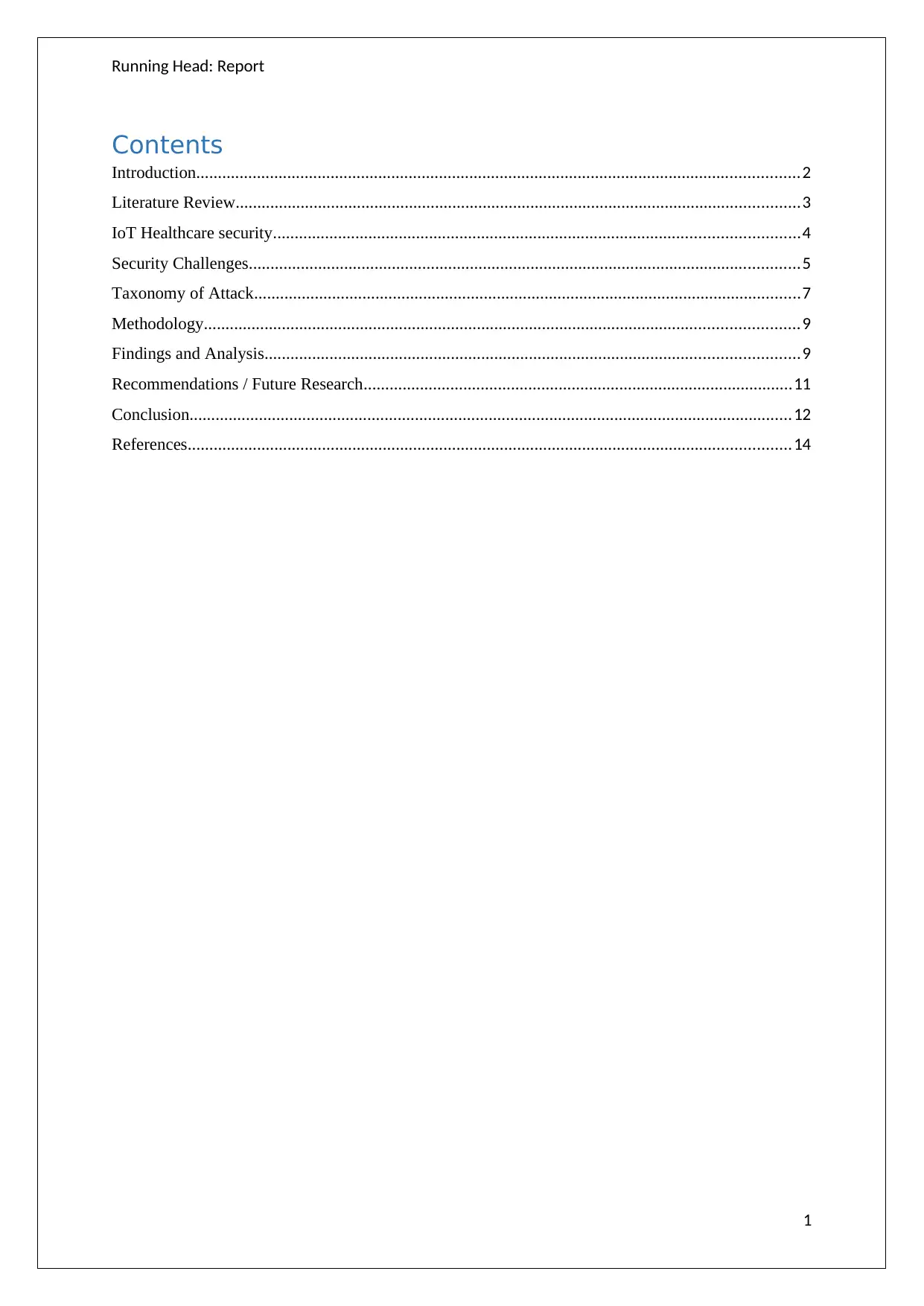
Running Head: Report
Contents
Introduction...........................................................................................................................................2
Literature Review..................................................................................................................................3
IoT Healthcare security.........................................................................................................................4
Security Challenges...............................................................................................................................5
Taxonomy of Attack..............................................................................................................................7
Methodology.........................................................................................................................................9
Findings and Analysis...........................................................................................................................9
Recommendations / Future Research...................................................................................................11
Conclusion...........................................................................................................................................12
References...........................................................................................................................................14
1
Contents
Introduction...........................................................................................................................................2
Literature Review..................................................................................................................................3
IoT Healthcare security.........................................................................................................................4
Security Challenges...............................................................................................................................5
Taxonomy of Attack..............................................................................................................................7
Methodology.........................................................................................................................................9
Findings and Analysis...........................................................................................................................9
Recommendations / Future Research...................................................................................................11
Conclusion...........................................................................................................................................12
References...........................................................................................................................................14
1
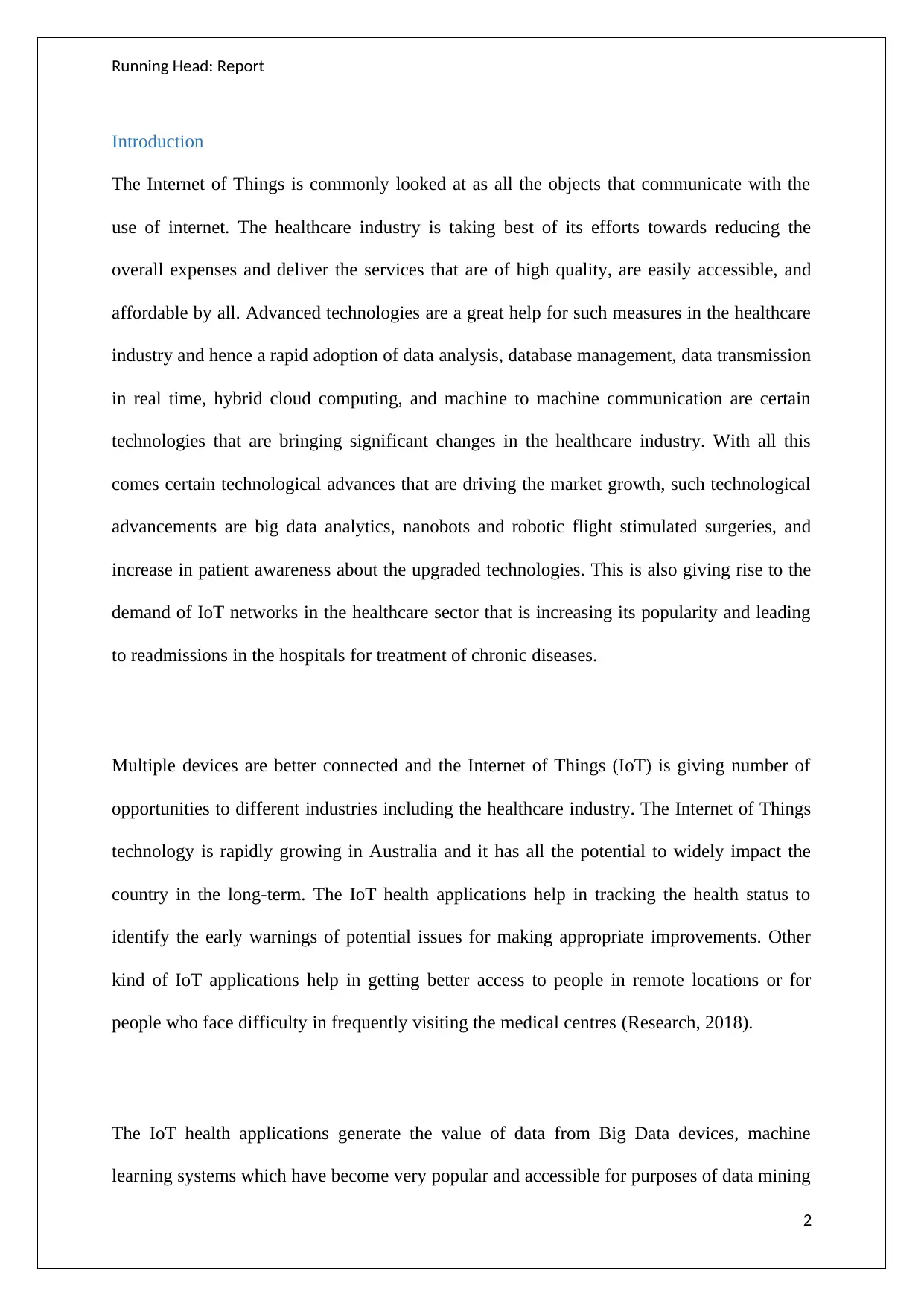
Running Head: Report
Introduction
The Internet of Things is commonly looked at as all the objects that communicate with the
use of internet. The healthcare industry is taking best of its efforts towards reducing the
overall expenses and deliver the services that are of high quality, are easily accessible, and
affordable by all. Advanced technologies are a great help for such measures in the healthcare
industry and hence a rapid adoption of data analysis, database management, data transmission
in real time, hybrid cloud computing, and machine to machine communication are certain
technologies that are bringing significant changes in the healthcare industry. With all this
comes certain technological advances that are driving the market growth, such technological
advancements are big data analytics, nanobots and robotic flight stimulated surgeries, and
increase in patient awareness about the upgraded technologies. This is also giving rise to the
demand of IoT networks in the healthcare sector that is increasing its popularity and leading
to readmissions in the hospitals for treatment of chronic diseases.
Multiple devices are better connected and the Internet of Things (IoT) is giving number of
opportunities to different industries including the healthcare industry. The Internet of Things
technology is rapidly growing in Australia and it has all the potential to widely impact the
country in the long-term. The IoT health applications help in tracking the health status to
identify the early warnings of potential issues for making appropriate improvements. Other
kind of IoT applications help in getting better access to people in remote locations or for
people who face difficulty in frequently visiting the medical centres (Research, 2018).
The IoT health applications generate the value of data from Big Data devices, machine
learning systems which have become very popular and accessible for purposes of data mining
2
Introduction
The Internet of Things is commonly looked at as all the objects that communicate with the
use of internet. The healthcare industry is taking best of its efforts towards reducing the
overall expenses and deliver the services that are of high quality, are easily accessible, and
affordable by all. Advanced technologies are a great help for such measures in the healthcare
industry and hence a rapid adoption of data analysis, database management, data transmission
in real time, hybrid cloud computing, and machine to machine communication are certain
technologies that are bringing significant changes in the healthcare industry. With all this
comes certain technological advances that are driving the market growth, such technological
advancements are big data analytics, nanobots and robotic flight stimulated surgeries, and
increase in patient awareness about the upgraded technologies. This is also giving rise to the
demand of IoT networks in the healthcare sector that is increasing its popularity and leading
to readmissions in the hospitals for treatment of chronic diseases.
Multiple devices are better connected and the Internet of Things (IoT) is giving number of
opportunities to different industries including the healthcare industry. The Internet of Things
technology is rapidly growing in Australia and it has all the potential to widely impact the
country in the long-term. The IoT health applications help in tracking the health status to
identify the early warnings of potential issues for making appropriate improvements. Other
kind of IoT applications help in getting better access to people in remote locations or for
people who face difficulty in frequently visiting the medical centres (Research, 2018).
The IoT health applications generate the value of data from Big Data devices, machine
learning systems which have become very popular and accessible for purposes of data mining
2
⊘ This is a preview!⊘
Do you want full access?
Subscribe today to unlock all pages.

Trusted by 1+ million students worldwide
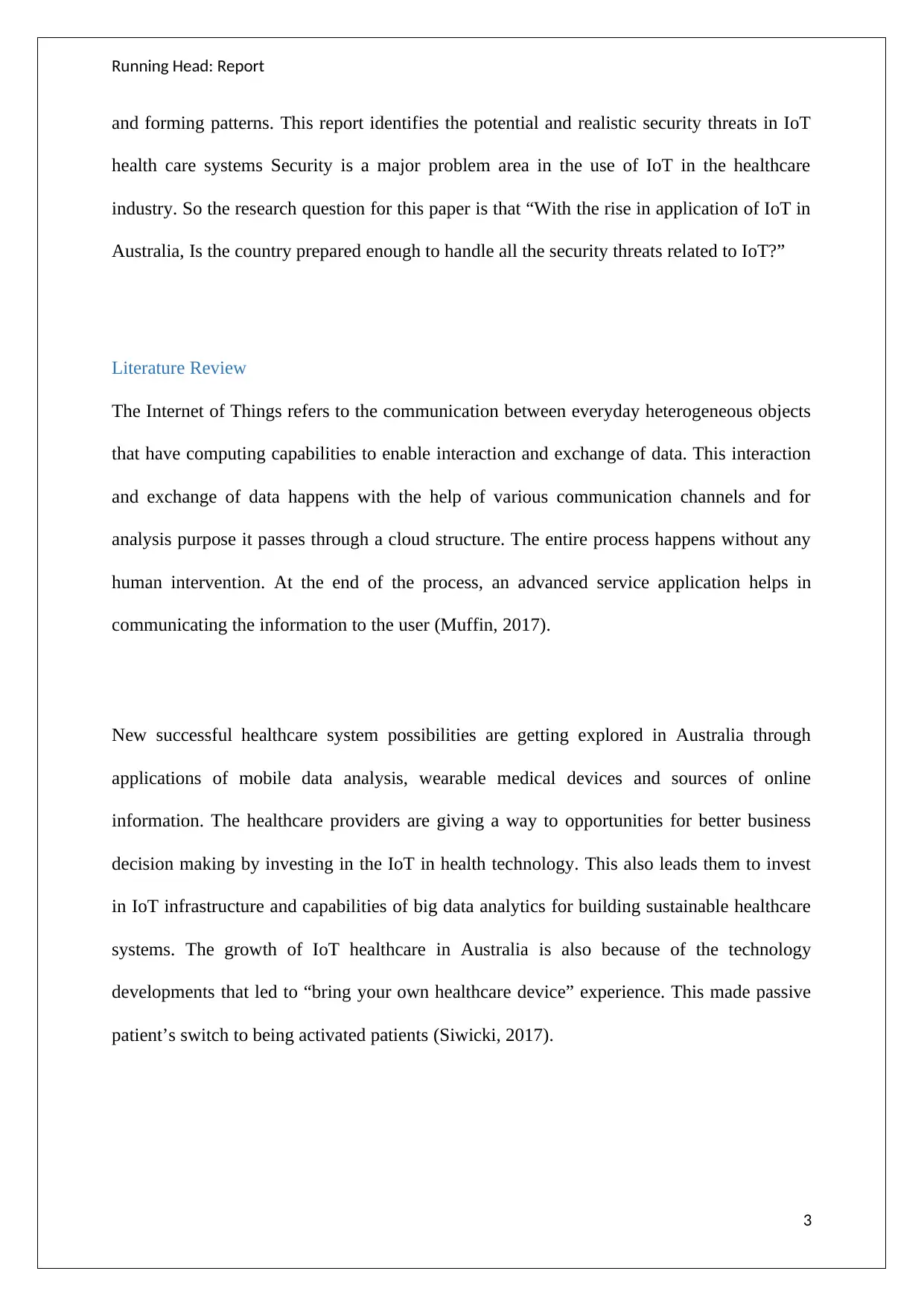
Running Head: Report
and forming patterns. This report identifies the potential and realistic security threats in IoT
health care systems Security is a major problem area in the use of IoT in the healthcare
industry. So the research question for this paper is that “With the rise in application of IoT in
Australia, Is the country prepared enough to handle all the security threats related to IoT?”
Literature Review
The Internet of Things refers to the communication between everyday heterogeneous objects
that have computing capabilities to enable interaction and exchange of data. This interaction
and exchange of data happens with the help of various communication channels and for
analysis purpose it passes through a cloud structure. The entire process happens without any
human intervention. At the end of the process, an advanced service application helps in
communicating the information to the user (Muffin, 2017).
New successful healthcare system possibilities are getting explored in Australia through
applications of mobile data analysis, wearable medical devices and sources of online
information. The healthcare providers are giving a way to opportunities for better business
decision making by investing in the IoT in health technology. This also leads them to invest
in IoT infrastructure and capabilities of big data analytics for building sustainable healthcare
systems. The growth of IoT healthcare in Australia is also because of the technology
developments that led to “bring your own healthcare device” experience. This made passive
patient’s switch to being activated patients (Siwicki, 2017).
3
and forming patterns. This report identifies the potential and realistic security threats in IoT
health care systems Security is a major problem area in the use of IoT in the healthcare
industry. So the research question for this paper is that “With the rise in application of IoT in
Australia, Is the country prepared enough to handle all the security threats related to IoT?”
Literature Review
The Internet of Things refers to the communication between everyday heterogeneous objects
that have computing capabilities to enable interaction and exchange of data. This interaction
and exchange of data happens with the help of various communication channels and for
analysis purpose it passes through a cloud structure. The entire process happens without any
human intervention. At the end of the process, an advanced service application helps in
communicating the information to the user (Muffin, 2017).
New successful healthcare system possibilities are getting explored in Australia through
applications of mobile data analysis, wearable medical devices and sources of online
information. The healthcare providers are giving a way to opportunities for better business
decision making by investing in the IoT in health technology. This also leads them to invest
in IoT infrastructure and capabilities of big data analytics for building sustainable healthcare
systems. The growth of IoT healthcare in Australia is also because of the technology
developments that led to “bring your own healthcare device” experience. This made passive
patient’s switch to being activated patients (Siwicki, 2017).
3
Paraphrase This Document
Need a fresh take? Get an instant paraphrase of this document with our AI Paraphraser
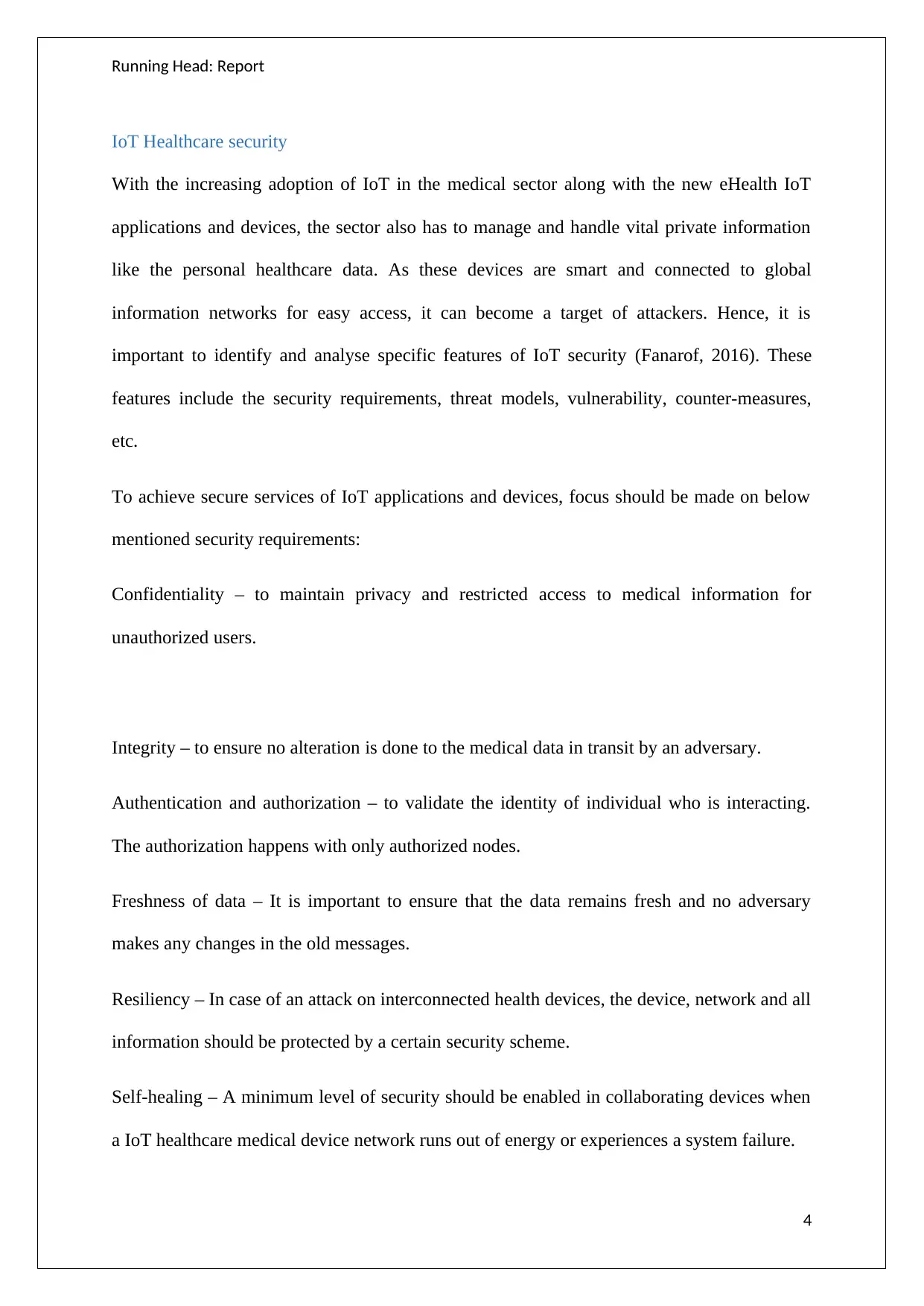
Running Head: Report
IoT Healthcare security
With the increasing adoption of IoT in the medical sector along with the new eHealth IoT
applications and devices, the sector also has to manage and handle vital private information
like the personal healthcare data. As these devices are smart and connected to global
information networks for easy access, it can become a target of attackers. Hence, it is
important to identify and analyse specific features of IoT security (Fanarof, 2016). These
features include the security requirements, threat models, vulnerability, counter-measures,
etc.
To achieve secure services of IoT applications and devices, focus should be made on below
mentioned security requirements:
Confidentiality – to maintain privacy and restricted access to medical information for
unauthorized users.
Integrity – to ensure no alteration is done to the medical data in transit by an adversary.
Authentication and authorization – to validate the identity of individual who is interacting.
The authorization happens with only authorized nodes.
Freshness of data – It is important to ensure that the data remains fresh and no adversary
makes any changes in the old messages.
Resiliency – In case of an attack on interconnected health devices, the device, network and all
information should be protected by a certain security scheme.
Self-healing – A minimum level of security should be enabled in collaborating devices when
a IoT healthcare medical device network runs out of energy or experiences a system failure.
4
IoT Healthcare security
With the increasing adoption of IoT in the medical sector along with the new eHealth IoT
applications and devices, the sector also has to manage and handle vital private information
like the personal healthcare data. As these devices are smart and connected to global
information networks for easy access, it can become a target of attackers. Hence, it is
important to identify and analyse specific features of IoT security (Fanarof, 2016). These
features include the security requirements, threat models, vulnerability, counter-measures,
etc.
To achieve secure services of IoT applications and devices, focus should be made on below
mentioned security requirements:
Confidentiality – to maintain privacy and restricted access to medical information for
unauthorized users.
Integrity – to ensure no alteration is done to the medical data in transit by an adversary.
Authentication and authorization – to validate the identity of individual who is interacting.
The authorization happens with only authorized nodes.
Freshness of data – It is important to ensure that the data remains fresh and no adversary
makes any changes in the old messages.
Resiliency – In case of an attack on interconnected health devices, the device, network and all
information should be protected by a certain security scheme.
Self-healing – A minimum level of security should be enabled in collaborating devices when
a IoT healthcare medical device network runs out of energy or experiences a system failure.
4
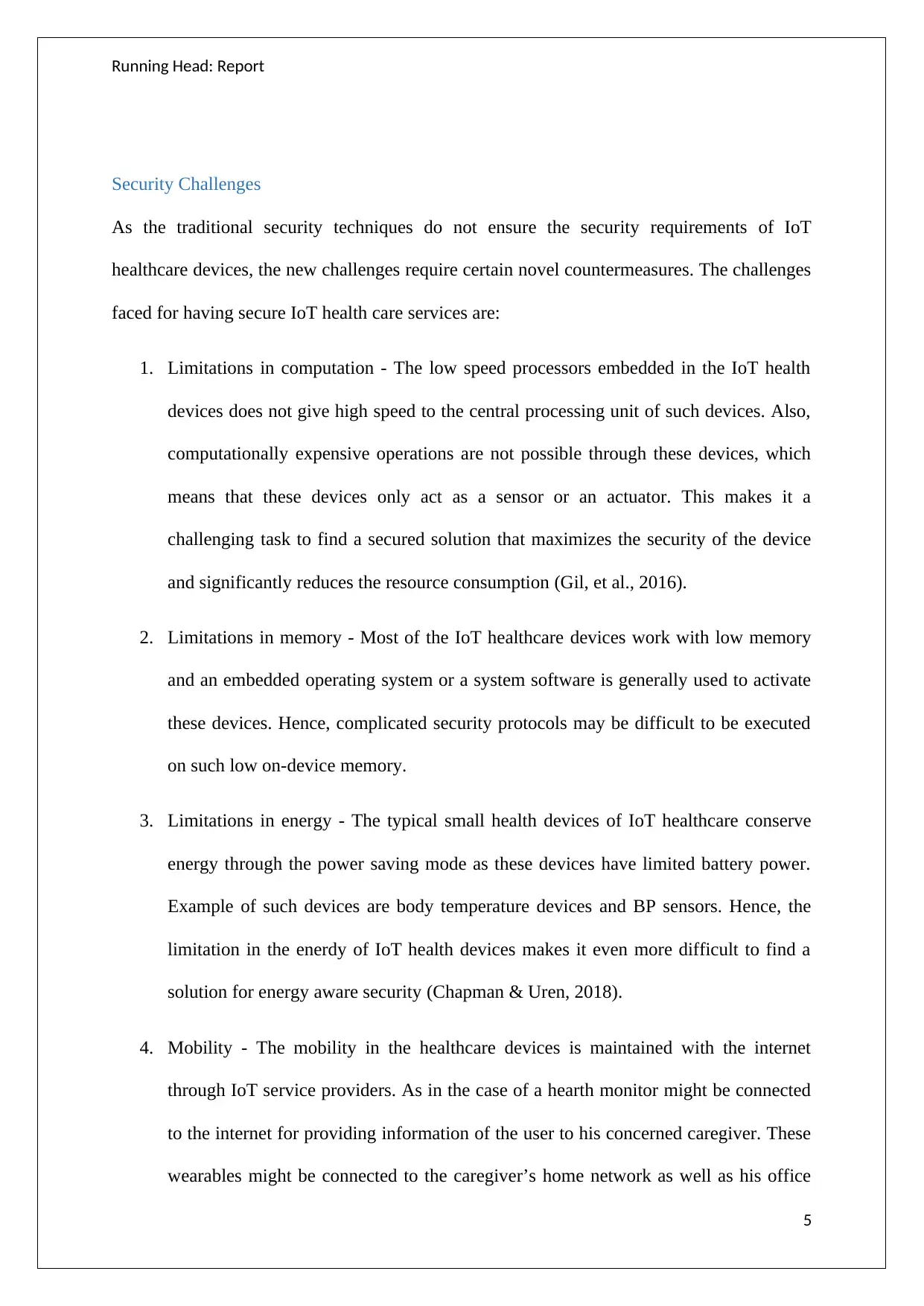
Running Head: Report
Security Challenges
As the traditional security techniques do not ensure the security requirements of IoT
healthcare devices, the new challenges require certain novel countermeasures. The challenges
faced for having secure IoT health care services are:
1. Limitations in computation - The low speed processors embedded in the IoT health
devices does not give high speed to the central processing unit of such devices. Also,
computationally expensive operations are not possible through these devices, which
means that these devices only act as a sensor or an actuator. This makes it a
challenging task to find a secured solution that maximizes the security of the device
and significantly reduces the resource consumption (Gil, et al., 2016).
2. Limitations in memory - Most of the IoT healthcare devices work with low memory
and an embedded operating system or a system software is generally used to activate
these devices. Hence, complicated security protocols may be difficult to be executed
on such low on-device memory.
3. Limitations in energy - The typical small health devices of IoT healthcare conserve
energy through the power saving mode as these devices have limited battery power.
Example of such devices are body temperature devices and BP sensors. Hence, the
limitation in the enerdy of IoT health devices makes it even more difficult to find a
solution for energy aware security (Chapman & Uren, 2018).
4. Mobility - The mobility in the healthcare devices is maintained with the internet
through IoT service providers. As in the case of a hearth monitor might be connected
to the internet for providing information of the user to his concerned caregiver. These
wearables might be connected to the caregiver’s home network as well as his office
5
Security Challenges
As the traditional security techniques do not ensure the security requirements of IoT
healthcare devices, the new challenges require certain novel countermeasures. The challenges
faced for having secure IoT health care services are:
1. Limitations in computation - The low speed processors embedded in the IoT health
devices does not give high speed to the central processing unit of such devices. Also,
computationally expensive operations are not possible through these devices, which
means that these devices only act as a sensor or an actuator. This makes it a
challenging task to find a secured solution that maximizes the security of the device
and significantly reduces the resource consumption (Gil, et al., 2016).
2. Limitations in memory - Most of the IoT healthcare devices work with low memory
and an embedded operating system or a system software is generally used to activate
these devices. Hence, complicated security protocols may be difficult to be executed
on such low on-device memory.
3. Limitations in energy - The typical small health devices of IoT healthcare conserve
energy through the power saving mode as these devices have limited battery power.
Example of such devices are body temperature devices and BP sensors. Hence, the
limitation in the enerdy of IoT health devices makes it even more difficult to find a
solution for energy aware security (Chapman & Uren, 2018).
4. Mobility - The mobility in the healthcare devices is maintained with the internet
through IoT service providers. As in the case of a hearth monitor might be connected
to the internet for providing information of the user to his concerned caregiver. These
wearables might be connected to the caregiver’s home network as well as his office
5
⊘ This is a preview!⊘
Do you want full access?
Subscribe today to unlock all pages.

Trusted by 1+ million students worldwide
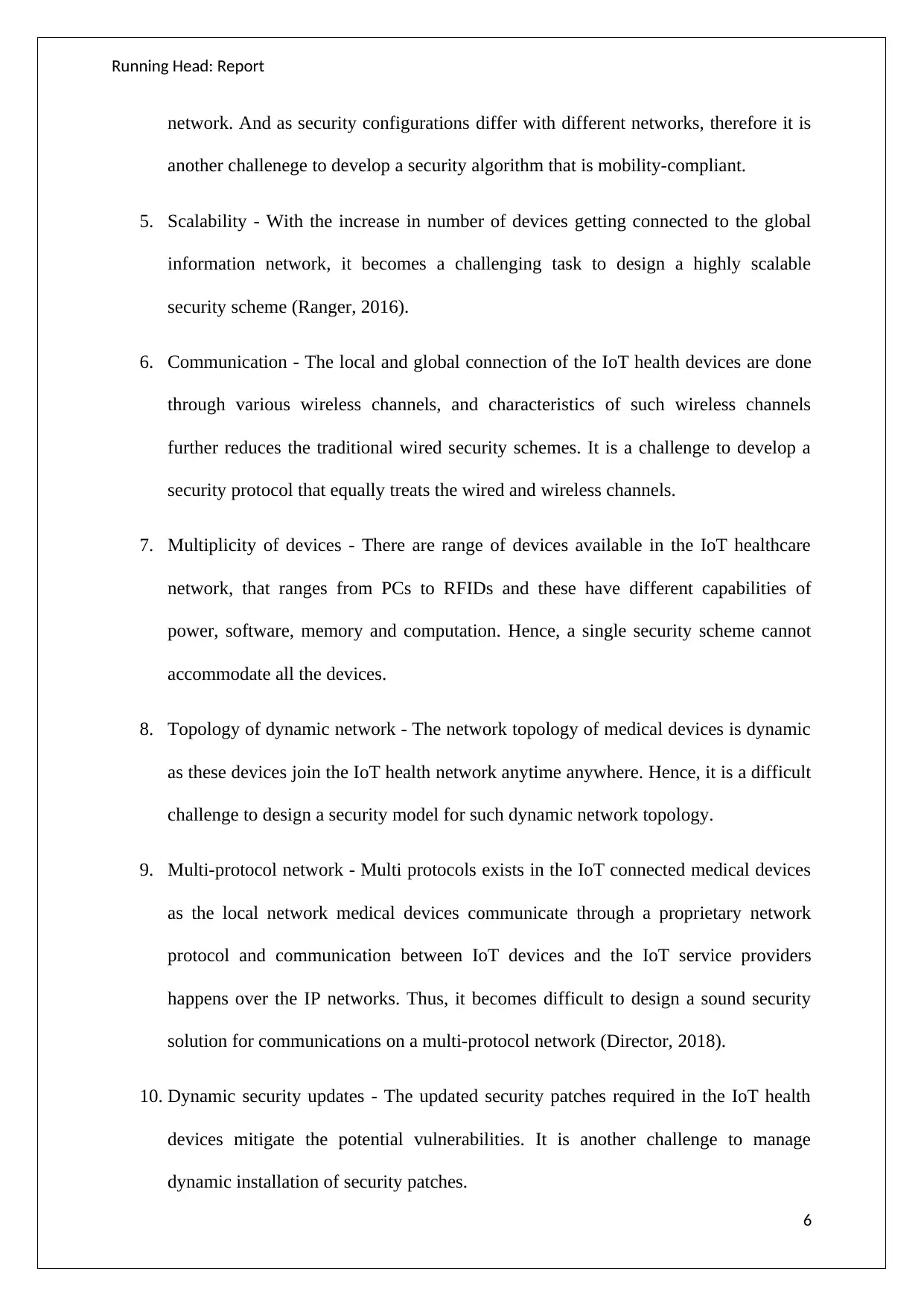
Running Head: Report
network. And as security configurations differ with different networks, therefore it is
another challenege to develop a security algorithm that is mobility-compliant.
5. Scalability - With the increase in number of devices getting connected to the global
information network, it becomes a challenging task to design a highly scalable
security scheme (Ranger, 2016).
6. Communication - The local and global connection of the IoT health devices are done
through various wireless channels, and characteristics of such wireless channels
further reduces the traditional wired security schemes. It is a challenge to develop a
security protocol that equally treats the wired and wireless channels.
7. Multiplicity of devices - There are range of devices available in the IoT healthcare
network, that ranges from PCs to RFIDs and these have different capabilities of
power, software, memory and computation. Hence, a single security scheme cannot
accommodate all the devices.
8. Topology of dynamic network - The network topology of medical devices is dynamic
as these devices join the IoT health network anytime anywhere. Hence, it is a difficult
challenge to design a security model for such dynamic network topology.
9. Multi-protocol network - Multi protocols exists in the IoT connected medical devices
as the local network medical devices communicate through a proprietary network
protocol and communication between IoT devices and the IoT service providers
happens over the IP networks. Thus, it becomes difficult to design a sound security
solution for communications on a multi-protocol network (Director, 2018).
10. Dynamic security updates - The updated security patches required in the IoT health
devices mitigate the potential vulnerabilities. It is another challenge to manage
dynamic installation of security patches.
6
network. And as security configurations differ with different networks, therefore it is
another challenege to develop a security algorithm that is mobility-compliant.
5. Scalability - With the increase in number of devices getting connected to the global
information network, it becomes a challenging task to design a highly scalable
security scheme (Ranger, 2016).
6. Communication - The local and global connection of the IoT health devices are done
through various wireless channels, and characteristics of such wireless channels
further reduces the traditional wired security schemes. It is a challenge to develop a
security protocol that equally treats the wired and wireless channels.
7. Multiplicity of devices - There are range of devices available in the IoT healthcare
network, that ranges from PCs to RFIDs and these have different capabilities of
power, software, memory and computation. Hence, a single security scheme cannot
accommodate all the devices.
8. Topology of dynamic network - The network topology of medical devices is dynamic
as these devices join the IoT health network anytime anywhere. Hence, it is a difficult
challenge to design a security model for such dynamic network topology.
9. Multi-protocol network - Multi protocols exists in the IoT connected medical devices
as the local network medical devices communicate through a proprietary network
protocol and communication between IoT devices and the IoT service providers
happens over the IP networks. Thus, it becomes difficult to design a sound security
solution for communications on a multi-protocol network (Director, 2018).
10. Dynamic security updates - The updated security patches required in the IoT health
devices mitigate the potential vulnerabilities. It is another challenge to manage
dynamic installation of security patches.
6
Paraphrase This Document
Need a fresh take? Get an instant paraphrase of this document with our AI Paraphraser
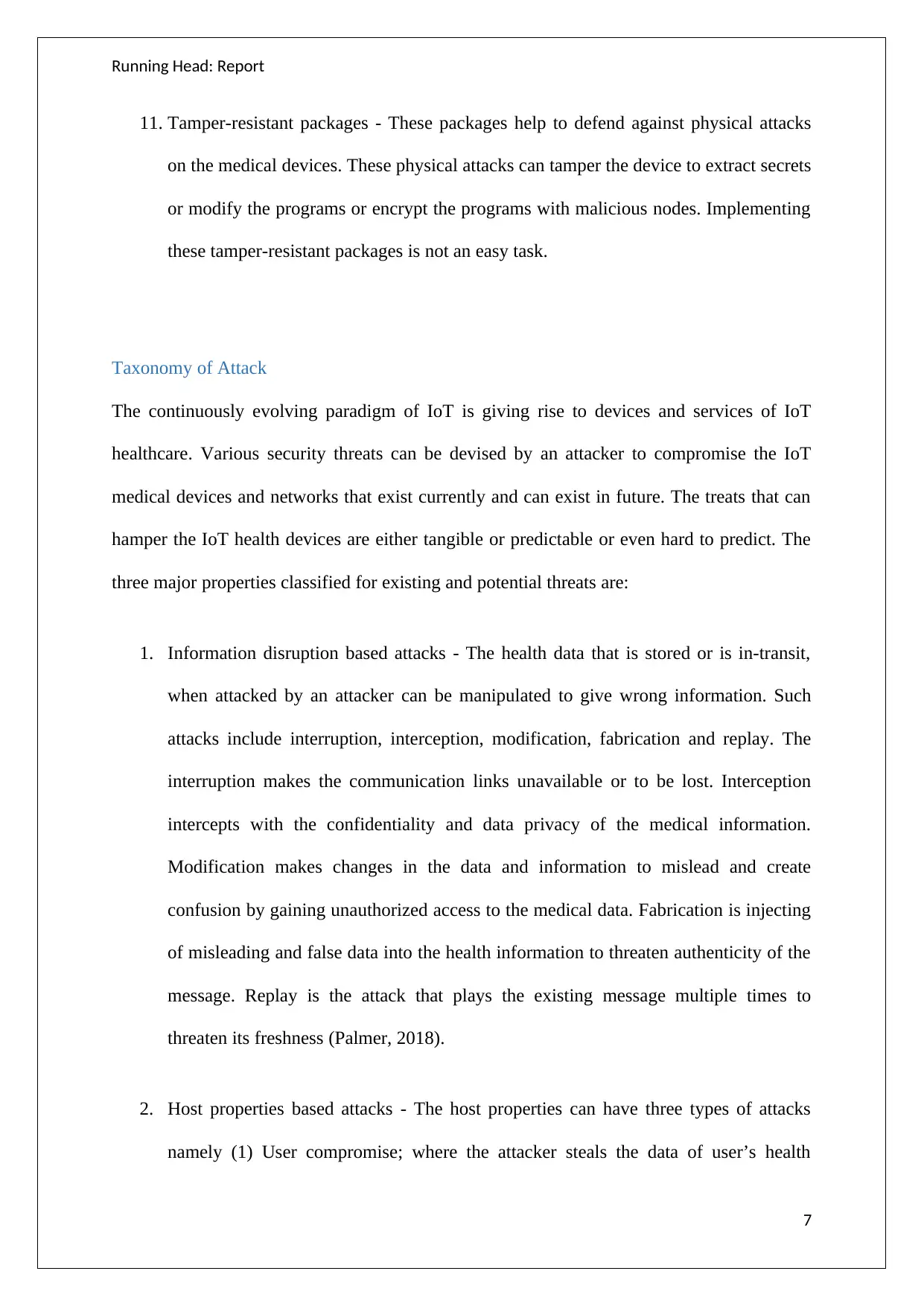
Running Head: Report
11. Tamper-resistant packages - These packages help to defend against physical attacks
on the medical devices. These physical attacks can tamper the device to extract secrets
or modify the programs or encrypt the programs with malicious nodes. Implementing
these tamper-resistant packages is not an easy task.
Taxonomy of Attack
The continuously evolving paradigm of IoT is giving rise to devices and services of IoT
healthcare. Various security threats can be devised by an attacker to compromise the IoT
medical devices and networks that exist currently and can exist in future. The treats that can
hamper the IoT health devices are either tangible or predictable or even hard to predict. The
three major properties classified for existing and potential threats are:
1. Information disruption based attacks - The health data that is stored or is in-transit,
when attacked by an attacker can be manipulated to give wrong information. Such
attacks include interruption, interception, modification, fabrication and replay. The
interruption makes the communication links unavailable or to be lost. Interception
intercepts with the confidentiality and data privacy of the medical information.
Modification makes changes in the data and information to mislead and create
confusion by gaining unauthorized access to the medical data. Fabrication is injecting
of misleading and false data into the health information to threaten authenticity of the
message. Replay is the attack that plays the existing message multiple times to
threaten its freshness (Palmer, 2018).
2. Host properties based attacks - The host properties can have three types of attacks
namely (1) User compromise; where the attacker steals the data of user’s health
7
11. Tamper-resistant packages - These packages help to defend against physical attacks
on the medical devices. These physical attacks can tamper the device to extract secrets
or modify the programs or encrypt the programs with malicious nodes. Implementing
these tamper-resistant packages is not an easy task.
Taxonomy of Attack
The continuously evolving paradigm of IoT is giving rise to devices and services of IoT
healthcare. Various security threats can be devised by an attacker to compromise the IoT
medical devices and networks that exist currently and can exist in future. The treats that can
hamper the IoT health devices are either tangible or predictable or even hard to predict. The
three major properties classified for existing and potential threats are:
1. Information disruption based attacks - The health data that is stored or is in-transit,
when attacked by an attacker can be manipulated to give wrong information. Such
attacks include interruption, interception, modification, fabrication and replay. The
interruption makes the communication links unavailable or to be lost. Interception
intercepts with the confidentiality and data privacy of the medical information.
Modification makes changes in the data and information to mislead and create
confusion by gaining unauthorized access to the medical data. Fabrication is injecting
of misleading and false data into the health information to threaten authenticity of the
message. Replay is the attack that plays the existing message multiple times to
threaten its freshness (Palmer, 2018).
2. Host properties based attacks - The host properties can have three types of attacks
namely (1) User compromise; where the attacker steals the data of user’s health
7
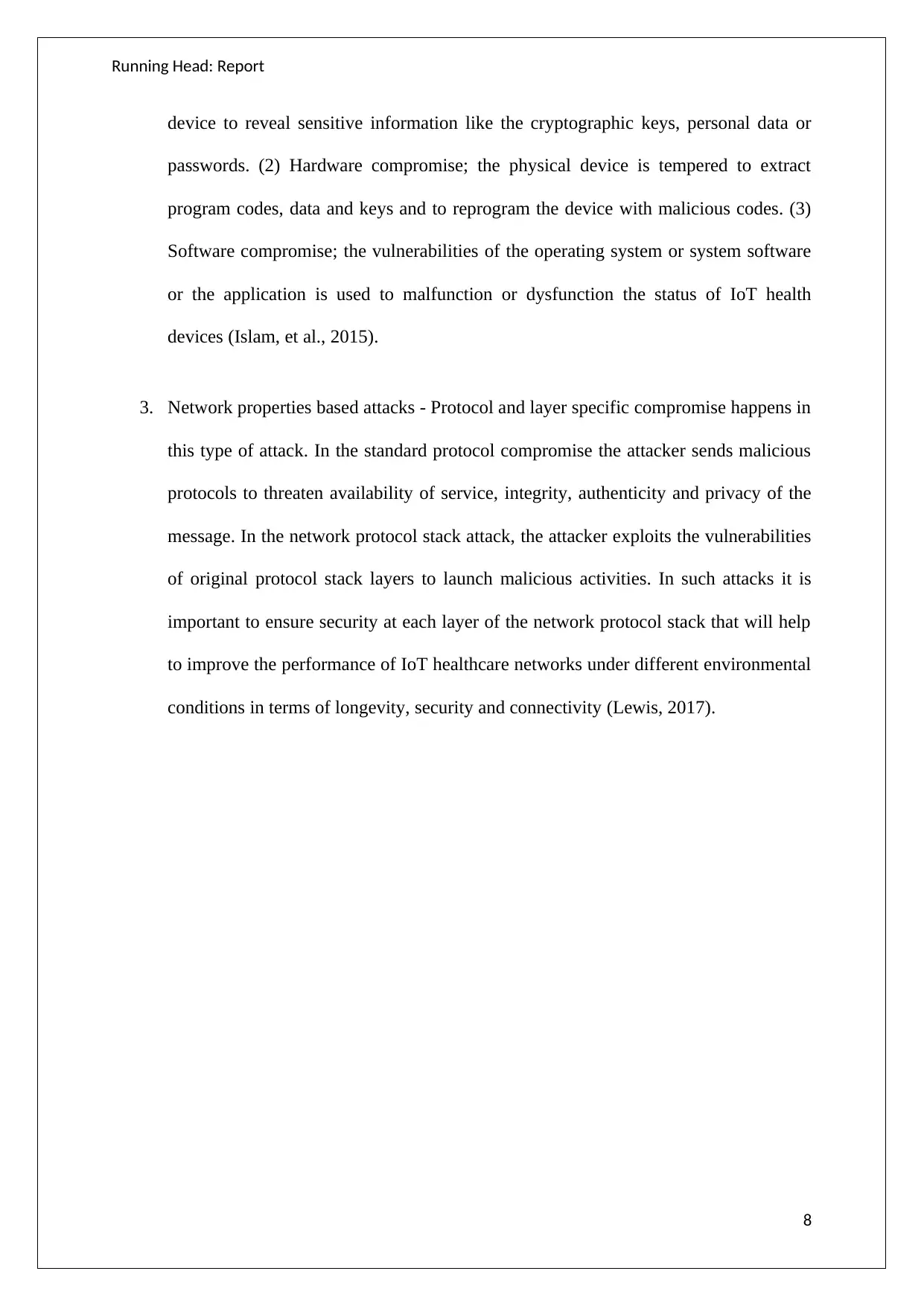
Running Head: Report
device to reveal sensitive information like the cryptographic keys, personal data or
passwords. (2) Hardware compromise; the physical device is tempered to extract
program codes, data and keys and to reprogram the device with malicious codes. (3)
Software compromise; the vulnerabilities of the operating system or system software
or the application is used to malfunction or dysfunction the status of IoT health
devices (Islam, et al., 2015).
3. Network properties based attacks - Protocol and layer specific compromise happens in
this type of attack. In the standard protocol compromise the attacker sends malicious
protocols to threaten availability of service, integrity, authenticity and privacy of the
message. In the network protocol stack attack, the attacker exploits the vulnerabilities
of original protocol stack layers to launch malicious activities. In such attacks it is
important to ensure security at each layer of the network protocol stack that will help
to improve the performance of IoT healthcare networks under different environmental
conditions in terms of longevity, security and connectivity (Lewis, 2017).
8
device to reveal sensitive information like the cryptographic keys, personal data or
passwords. (2) Hardware compromise; the physical device is tempered to extract
program codes, data and keys and to reprogram the device with malicious codes. (3)
Software compromise; the vulnerabilities of the operating system or system software
or the application is used to malfunction or dysfunction the status of IoT health
devices (Islam, et al., 2015).
3. Network properties based attacks - Protocol and layer specific compromise happens in
this type of attack. In the standard protocol compromise the attacker sends malicious
protocols to threaten availability of service, integrity, authenticity and privacy of the
message. In the network protocol stack attack, the attacker exploits the vulnerabilities
of original protocol stack layers to launch malicious activities. In such attacks it is
important to ensure security at each layer of the network protocol stack that will help
to improve the performance of IoT healthcare networks under different environmental
conditions in terms of longevity, security and connectivity (Lewis, 2017).
8
⊘ This is a preview!⊘
Do you want full access?
Subscribe today to unlock all pages.

Trusted by 1+ million students worldwide
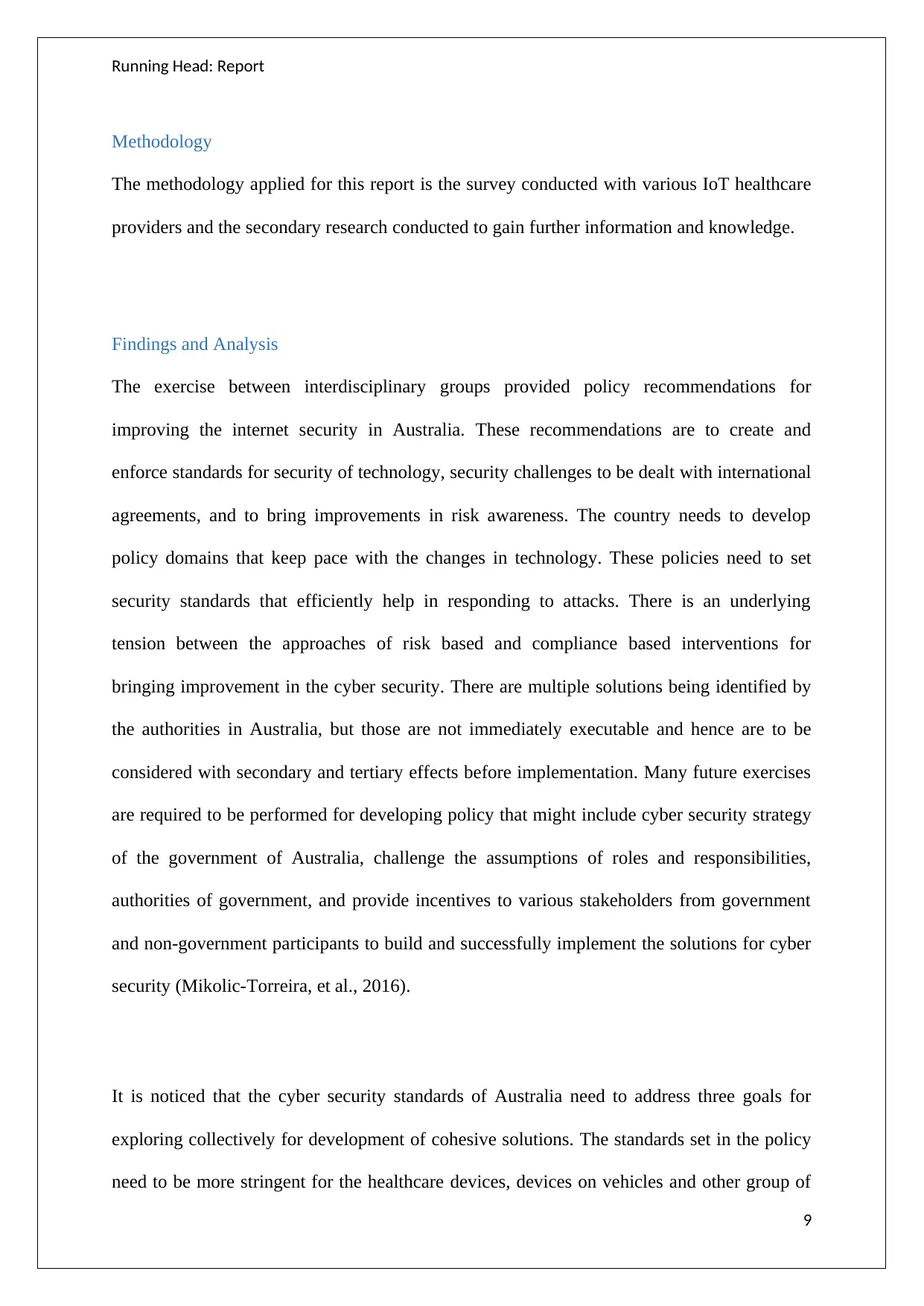
Running Head: Report
Methodology
The methodology applied for this report is the survey conducted with various IoT healthcare
providers and the secondary research conducted to gain further information and knowledge.
Findings and Analysis
The exercise between interdisciplinary groups provided policy recommendations for
improving the internet security in Australia. These recommendations are to create and
enforce standards for security of technology, security challenges to be dealt with international
agreements, and to bring improvements in risk awareness. The country needs to develop
policy domains that keep pace with the changes in technology. These policies need to set
security standards that efficiently help in responding to attacks. There is an underlying
tension between the approaches of risk based and compliance based interventions for
bringing improvement in the cyber security. There are multiple solutions being identified by
the authorities in Australia, but those are not immediately executable and hence are to be
considered with secondary and tertiary effects before implementation. Many future exercises
are required to be performed for developing policy that might include cyber security strategy
of the government of Australia, challenge the assumptions of roles and responsibilities,
authorities of government, and provide incentives to various stakeholders from government
and non-government participants to build and successfully implement the solutions for cyber
security (Mikolic-Torreira, et al., 2016).
It is noticed that the cyber security standards of Australia need to address three goals for
exploring collectively for development of cohesive solutions. The standards set in the policy
need to be more stringent for the healthcare devices, devices on vehicles and other group of
9
Methodology
The methodology applied for this report is the survey conducted with various IoT healthcare
providers and the secondary research conducted to gain further information and knowledge.
Findings and Analysis
The exercise between interdisciplinary groups provided policy recommendations for
improving the internet security in Australia. These recommendations are to create and
enforce standards for security of technology, security challenges to be dealt with international
agreements, and to bring improvements in risk awareness. The country needs to develop
policy domains that keep pace with the changes in technology. These policies need to set
security standards that efficiently help in responding to attacks. There is an underlying
tension between the approaches of risk based and compliance based interventions for
bringing improvement in the cyber security. There are multiple solutions being identified by
the authorities in Australia, but those are not immediately executable and hence are to be
considered with secondary and tertiary effects before implementation. Many future exercises
are required to be performed for developing policy that might include cyber security strategy
of the government of Australia, challenge the assumptions of roles and responsibilities,
authorities of government, and provide incentives to various stakeholders from government
and non-government participants to build and successfully implement the solutions for cyber
security (Mikolic-Torreira, et al., 2016).
It is noticed that the cyber security standards of Australia need to address three goals for
exploring collectively for development of cohesive solutions. The standards set in the policy
need to be more stringent for the healthcare devices, devices on vehicles and other group of
9
Paraphrase This Document
Need a fresh take? Get an instant paraphrase of this document with our AI Paraphraser
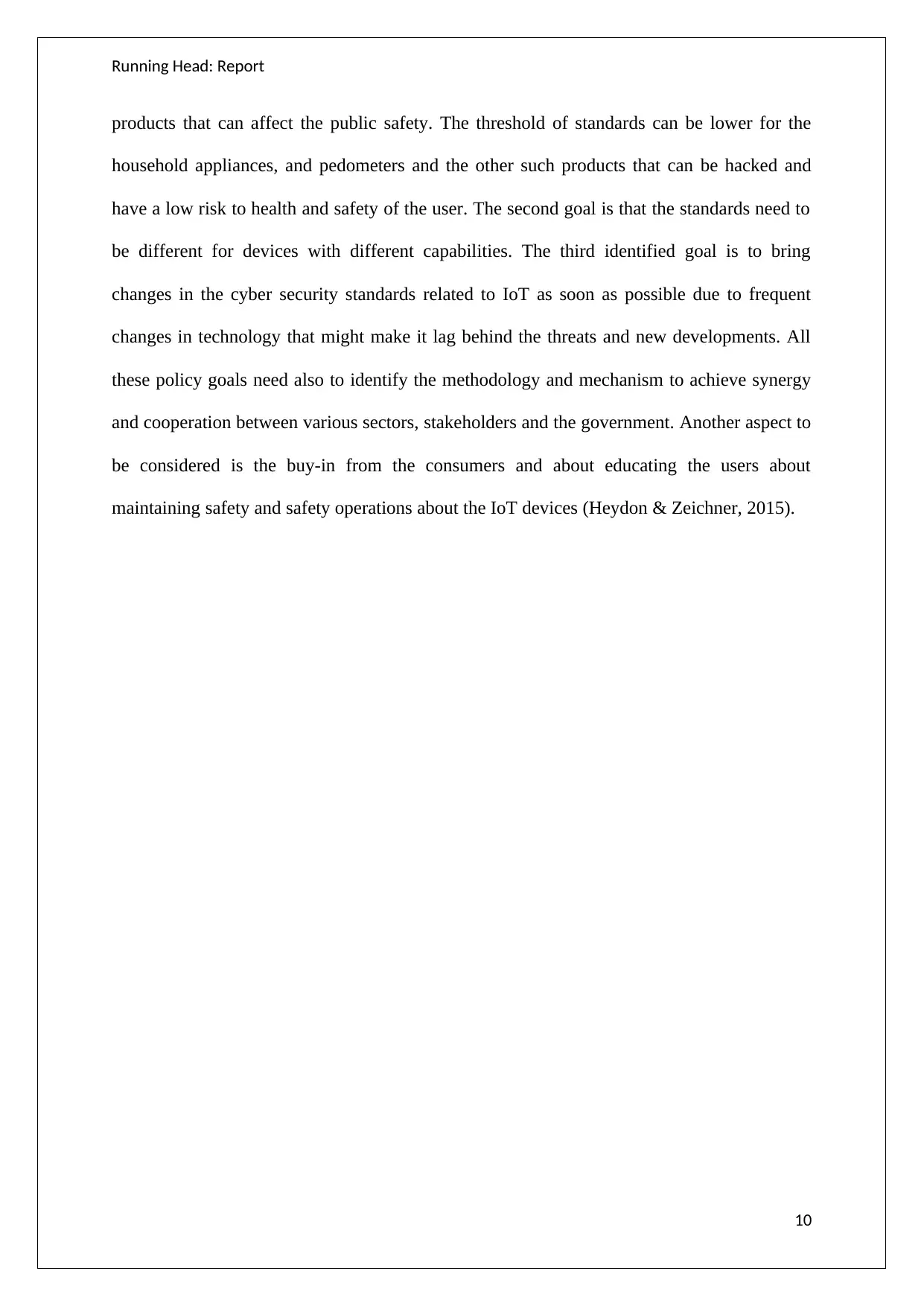
Running Head: Report
products that can affect the public safety. The threshold of standards can be lower for the
household appliances, and pedometers and the other such products that can be hacked and
have a low risk to health and safety of the user. The second goal is that the standards need to
be different for devices with different capabilities. The third identified goal is to bring
changes in the cyber security standards related to IoT as soon as possible due to frequent
changes in technology that might make it lag behind the threats and new developments. All
these policy goals need also to identify the methodology and mechanism to achieve synergy
and cooperation between various sectors, stakeholders and the government. Another aspect to
be considered is the buy-in from the consumers and about educating the users about
maintaining safety and safety operations about the IoT devices (Heydon & Zeichner, 2015).
10
products that can affect the public safety. The threshold of standards can be lower for the
household appliances, and pedometers and the other such products that can be hacked and
have a low risk to health and safety of the user. The second goal is that the standards need to
be different for devices with different capabilities. The third identified goal is to bring
changes in the cyber security standards related to IoT as soon as possible due to frequent
changes in technology that might make it lag behind the threats and new developments. All
these policy goals need also to identify the methodology and mechanism to achieve synergy
and cooperation between various sectors, stakeholders and the government. Another aspect to
be considered is the buy-in from the consumers and about educating the users about
maintaining safety and safety operations about the IoT devices (Heydon & Zeichner, 2015).
10
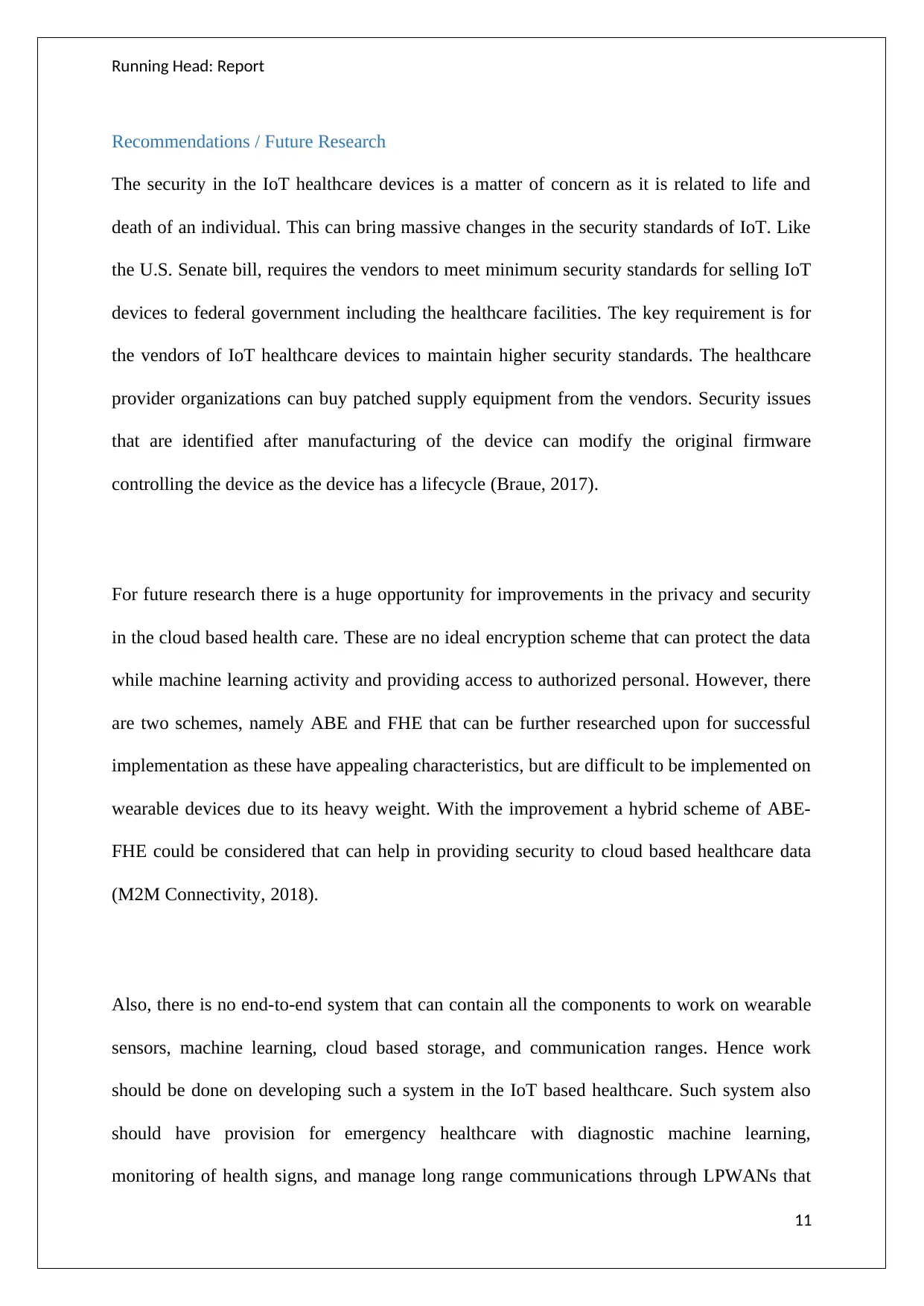
Running Head: Report
Recommendations / Future Research
The security in the IoT healthcare devices is a matter of concern as it is related to life and
death of an individual. This can bring massive changes in the security standards of IoT. Like
the U.S. Senate bill, requires the vendors to meet minimum security standards for selling IoT
devices to federal government including the healthcare facilities. The key requirement is for
the vendors of IoT healthcare devices to maintain higher security standards. The healthcare
provider organizations can buy patched supply equipment from the vendors. Security issues
that are identified after manufacturing of the device can modify the original firmware
controlling the device as the device has a lifecycle (Braue, 2017).
For future research there is a huge opportunity for improvements in the privacy and security
in the cloud based health care. These are no ideal encryption scheme that can protect the data
while machine learning activity and providing access to authorized personal. However, there
are two schemes, namely ABE and FHE that can be further researched upon for successful
implementation as these have appealing characteristics, but are difficult to be implemented on
wearable devices due to its heavy weight. With the improvement a hybrid scheme of ABE-
FHE could be considered that can help in providing security to cloud based healthcare data
(M2M Connectivity, 2018).
Also, there is no end-to-end system that can contain all the components to work on wearable
sensors, machine learning, cloud based storage, and communication ranges. Hence work
should be done on developing such a system in the IoT based healthcare. Such system also
should have provision for emergency healthcare with diagnostic machine learning,
monitoring of health signs, and manage long range communications through LPWANs that
11
Recommendations / Future Research
The security in the IoT healthcare devices is a matter of concern as it is related to life and
death of an individual. This can bring massive changes in the security standards of IoT. Like
the U.S. Senate bill, requires the vendors to meet minimum security standards for selling IoT
devices to federal government including the healthcare facilities. The key requirement is for
the vendors of IoT healthcare devices to maintain higher security standards. The healthcare
provider organizations can buy patched supply equipment from the vendors. Security issues
that are identified after manufacturing of the device can modify the original firmware
controlling the device as the device has a lifecycle (Braue, 2017).
For future research there is a huge opportunity for improvements in the privacy and security
in the cloud based health care. These are no ideal encryption scheme that can protect the data
while machine learning activity and providing access to authorized personal. However, there
are two schemes, namely ABE and FHE that can be further researched upon for successful
implementation as these have appealing characteristics, but are difficult to be implemented on
wearable devices due to its heavy weight. With the improvement a hybrid scheme of ABE-
FHE could be considered that can help in providing security to cloud based healthcare data
(M2M Connectivity, 2018).
Also, there is no end-to-end system that can contain all the components to work on wearable
sensors, machine learning, cloud based storage, and communication ranges. Hence work
should be done on developing such a system in the IoT based healthcare. Such system also
should have provision for emergency healthcare with diagnostic machine learning,
monitoring of health signs, and manage long range communications through LPWANs that
11
⊘ This is a preview!⊘
Do you want full access?
Subscribe today to unlock all pages.

Trusted by 1+ million students worldwide
1 out of 17
Related Documents
Your All-in-One AI-Powered Toolkit for Academic Success.
+13062052269
info@desklib.com
Available 24*7 on WhatsApp / Email
![[object Object]](/_next/static/media/star-bottom.7253800d.svg)
Unlock your academic potential
Copyright © 2020–2025 A2Z Services. All Rights Reserved. Developed and managed by ZUCOL.





